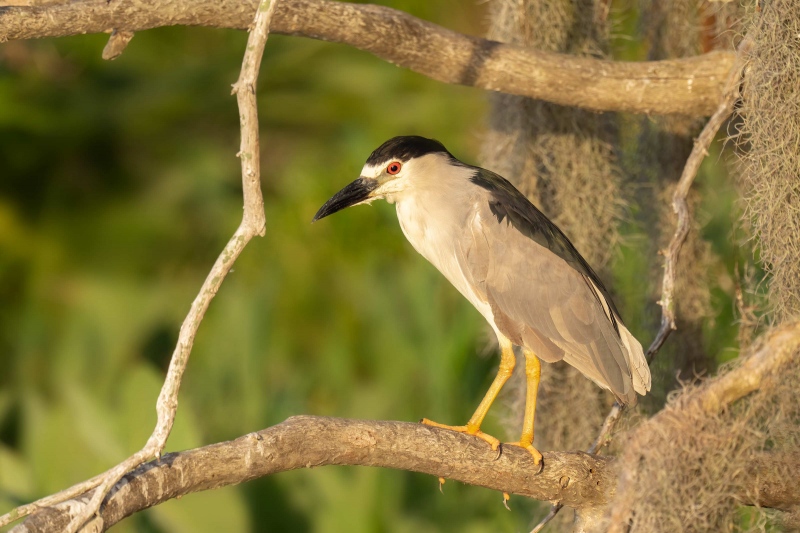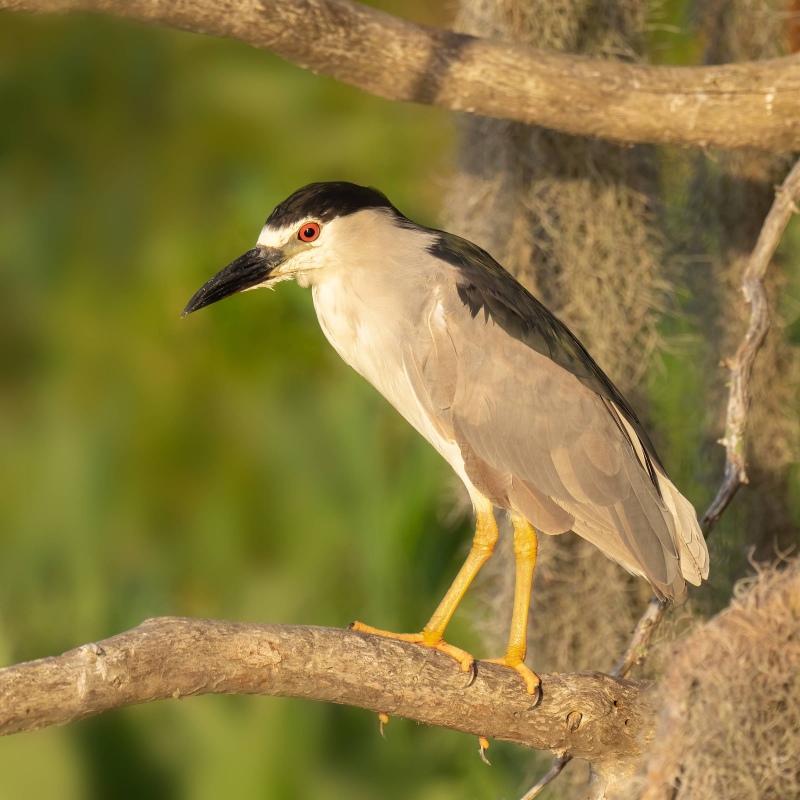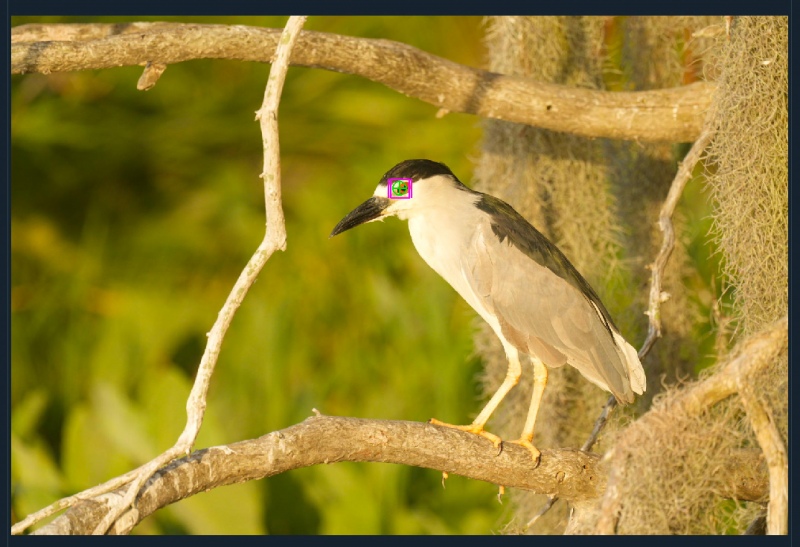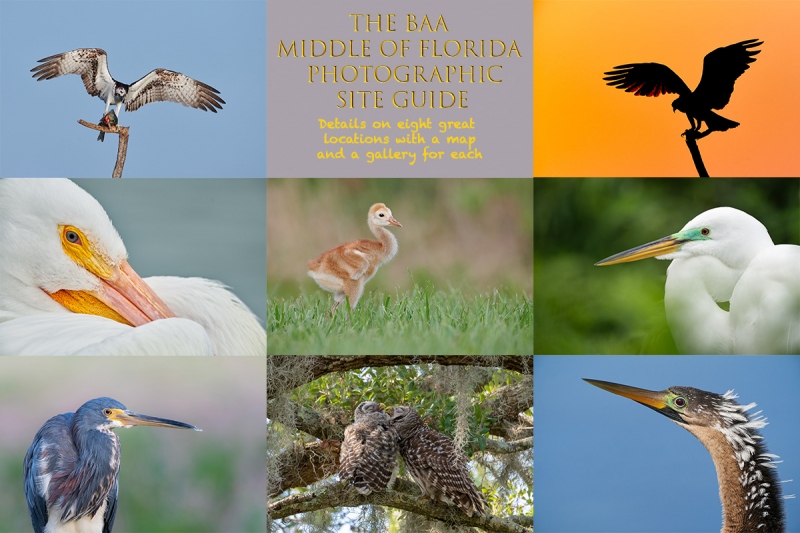What’s Up?
Jim and I made it early to the Circle Bar B Reserve in Lakeland. He carried the 600 f/4, and I carried the 70-200 II and a tripod. I had three TCs along for the ride. We walked three miles. For the first mile plus, we saw no birds. Then on the western shore of Lake Hancock, we came upon a big feeding spree of herons and egrets. Lots of wood Storks flew by. I tried a few silhouettes at 840mm, but the birds were very skittish … We walked out on the gazebo pier to get the sun behind us; I had a few decent chances. The best of those led to the creation of the two versions of today’s featured image below. At about 8:15am, we headed back to the car via the circular path. For that last mile plus, we saw no birds.
In the afternoon, I did some housework in preparation of giving away a ton of old cloths and enjoyed my 1/2-mile slow swim. After dinner it was 20 minutes of rope flow practice. The ILE forecast for this morning is for partly cloudy with a gentle breeze from the south. That usually means clear and sunny. I will be heading down to the lake early hoping to work again with the new Sony 400mm f/2.8 GM lens. Wherever you are and whatever you are doing, I hope that you too have a great day. This blog post took about an hour to prepare and makes seventy-three days in a row with a new one.
Please remember to use the B&H and Amazon links that are found on most blog pages and to use the BIRDSASART discount code at checkout when purchasing your new gear from Bedfords. Please, also, consider joining a BAA IPT. You will be amazed at how much you will learn!
BIRDS AS ART Image Optimization Service (BAA IOS)
Send a PayPal for $62.00 to birdsasart@verizon.net or call Jim at 863-692-0906 and put $62.00 on your credit card. Pick one of your best images and upload the raw file using a large file sending service like Hightail or DropBox and then send me the link via e-mail. I will download and save your raw file, evaluate the exposure and sharpness, and optimize the image as if it were my own after converting the raw file in Adobe Camera Raw. Best of all, I will make a screen recording of the entire process and send you a link to the video to download, save and study.
|
|
|
This image was also created on 26 May 2022 at Circle Bar B Reserve in Lakeland, FL. I used the no-longer available Induro GIT304L Stealth Carbon Fiber Tripod/Levered-Clamp FlexShooter Pro-mounted-Sony FE 600mm f/4 GM OSS lens, the Sony FE 2.0x Teleconverter, and The One, the Sony Alpha 1 Mirrorless Digital Camera). The exposure was determined via Zebra technology with ISO on the Thumb Dial. ISO 1000. 1/640 sec. at f/8 (wide open) in Manual mode. When evaluated in RawDigger, the raw file brightness was determined to be dead-solid perfect. AWB at 7:10:44am on sunny morning. Tracking: Spot S AF-C with Bird Face/Eye detection enabled performed to perfection. Be sure to click on the image to enjoy a high-res version. Image #1: Black-crowned Night-Heron adult (3X2) |
What the 400mm f/2.8 Lenses Cannot Do …
This is a small crop from the original — see 1B below for the full frame image. The 600mm f/4 lenses with a 2X TC get you to 1200mm. Note: with Sony, creating sharp images at 1200mm is as close to child’s play as you can come. The 400mm f/2.8 lenses with a 2X TC get you to 800mm. So, we are comparing 1200mm to 800mm. It would seem that the subject would be “only” 50% larger in the frame. But the relationship between the focal length and the size of the bird in the frame is not a linear one. It is a function of the square of the focal length:
Eight squared is 64. Twelve squared is 144. 144/64 = 2.25. Therefore, the size of the bird in the frame at 1200mm is 2 1/4 times larger than the size of the bird in the frame at 800mm. Note that if you remove the TCs from the equation, the math remains the same.
For the past three decades, I have been saying this: a longer, slower lens is a better choice for bird photography than a faster, shorter lens. You must also remember that lenses are tools. I am blessed to be able to own and use two of the best tools ever created for bird photography. Until I buy the farm, I can guarantee that I will continue making great images with both the 600mm f/4 and the 400mm f/2.8. But when you need the most reach, the 600s are the ticket.
|
|
|
This, the same image, was created on 26 May 2022 at Circle Bar B Reserve in Lakeland, FL. I used the no-longer available Induro GIT304L Stealth Carbon Fiber Tripod/Levered-Clamp FlexShooter Pro-mounted-Sony FE 600mm f/4 GM OSS lens, the Sony FE 2.0x Teleconverter, and The One, the Sony Alpha 1 Mirrorless Digital Camera). The exposure was determined via Zebra technology with ISO on the Thumb Dial. ISO 1000. 1/640 sec. at f/8 (wide open) in Manual mode. When evaluated in RawDigger, the raw file brightness was determined to be dead-solid perfect. AWB at 7:10:44am on sunny morning. Tracking: Spot S AF-C with Bird Face/Eye detection enabled performed to perfection. Be sure to click on the image to enjoy a high-res version. Image #2: Black-crowned Night-Heron adult (SQUARE) |
What’s Your Call?
Which of today’s two featured images do you like best, Image #1, the 3X2 version, or Image #2, the square version with part of the vertical branch on the left removed? If you leave a comment, please let us know why you made your choice.
|
|
Image #3: A7INFO screen capture for the Black-crowned Night-Heron adult image |
AF-C with Bird Face/Eye Detection Enabled at 1200mm
When working at 1200mm (as I do often), the performance of continuous autofocus (AF-C) with Bird Face/Eye detection enabled is often astounding. At times it will acquire and track the bird’s eye as seen in the screen capture above, and at times it will detect and track the bird’s face. Though that is less impressive, the images in either case are razor-sharp.
|
|
The BAA Middle of Florida Photographic Site GuideYou can purchase your copy here in the BAA Online Store. |
The BAA Middle of Florida Photographic Site Guide
126 pages, 87 photographs by Joe Przybyla and Arthur Morris.
The PDF for this e-Guide is an electronic download sent via e-mail.
Purchase your copy here in the BAA Online Store.
I had thought about doing a guide to some of the great but little-known photo hotspots around central Florida for about a decade, but those plans never came to fruition. I met Joe online in the Avian Forum at BirdPhotographer’s.Net about two years ago. Joe’s photography has improved tremendously over the past few years; he credits the BAA blog, my books and PDFs, and his participation on BPN. The one thing that I learned right from the get-go about Joe is that he is a hard and tenacious worker, always striving to improve his skills and to grow his knowledge base. As he knew of more than a few good spots in central Florida, I broached the idea of us doing a photographic site guide that covered many of the little-known photographic hotspots from Brandon to Lakeland to Joe Overstreet Road to Indian Lake Estates (my Florida home for the past 20 years or so). After more than many, many dozens of hours of effort, The BIRDS AS ART Middle of Florida Photographic Site Guide is now a reality. Thanks to Joe’s wife Dottie for her review of our writing. We all learned once again that writing is a process, a back-and-forth process. All thanks to the white pelicans of Lakeland. Here are the locations that are detailed in this e-Guide:
- Indian Lake Estates: Sandhills Cranes with chicks and colts, lots of vultures, and Ospreys up the kazoo!
- Gatorland, Kissimmee: Learn to make great images of wading birds in a cluttered rookery.
- The Brandon Rookery: Great for nesting Wood Storks, Great Egrets, and more.
- Circle Bar B Reserve, Lakeland: Here you will find a great variety of avian subjects in a great variety of habitats.
- Lake Morton, Lakeland: There are lots of silly tame birds here including and especially American White Pelican during the colder months.
- Lake Mirror, Lakeland: Tame Anhingas, Limpkins, and a zillion White Ibises at times.
- West Lake Parker, Lakeland: Here you will have a chance for two difficult birds, Snail Kite, and Purple Gallinule.
- Joe Overstreet Road, Kenansville: Crested Caracara, meadowlarks, Loggerhead Shrike, and much more on the fenceposts and barbed wire.
Each location includes a map, a detailed description of the best spots, best season, light and time of day instructions, the expected species, and an educational and inspirational gallery that is designed to open your eyes as to the possibilities.
You can purchase a copy here in the BAA Online Store.
Typos
With all blog posts, feel free to e-mail or to leave a comment regarding any typos or errors.


















I love Image 2 for all the reasons everyone else does!
Good morning Guru. This is Sanjeed from Bangladesh.
I take your advice of longer and slower is better than faster and shorter lens to heart. So, I plan for myself and advice to others the following in near future:
Canon EOS R7 + Canon RF 100-500mm f/4.5-7.1 L IS USM though, the telezoom lens is not a very affordable glass for hobbyists like me.
Best regards.
No. 2 for me. It is a cleaner image with the stick removed. I like the way the upper and lower branches create a frame on the right side of the image and the bird is looking to the left which lets the left side of the image complete the frame. Just curious, have you tried flipping the image in PS so the bird looks to the right? I do that quite a bit because we read from left to right. Great image with good color balance. Thanks for sharing. FYI, loving my Flexshooter levered tripod head.
Thanks on all counts, Jim. How about a 3X2 with the branch removed? (That would be a lot more work — why?)
with love, artie
I used the EF 400 f2.8 extensively on Midway. Tame birds and a need for shallow DOF to blur messy backgrounds. Worked well with flight shots. The 1.4x and 2x seldom needed. Otherwise, I’ve relied on a 600 for birds. Never a big fan of the 800 as FD min focus distance poor and EF basically a small birds lens ie limited versatility.
The 400 in my experience is good for mammals too. Similar reasons with 1.4x and 2x giving you roughly a 600 f4 and 800 f5.6. Good low light and background control.
In general, I’ve found 400 short. 500 for example makes a better general purpose lens. Zooms the best if it will work for your situation. While a fixed lens is typically better optically, the versatility of a zoom trumps (bridge card game term not political) all.
Thanks, Bob. I could not disagree with anything you say about the 400 f/2.8. I am liking it more every day. But it will never give you 1200mm :).
I got one great shot on Midway with the EF 800mm f5/6L lens — a head shot of a Short-tailed Albatross.
with love, artie
To me, composition #2 captures the essence of the scene without distraction from the vertical branch on the left. The composition is much cleaner and the level of detail is not lost in the crop.
I like the composition of image 1 much better but that vertical branch is a killer.
Thanks, David. The vertical branch is the vertical branch 🙂 It would be a lot more work to eliminate in the 3X2 version — why)
Do you ever like a square crop?
with love, artie
I liked #1 a lot. Then I saw #2 and it far surpassed #1. #2 is level with the bird giving more connection with it. Removal of the left branch makes the composition even better for me. Even with the cropping and very nice OOF background habitat still shows.